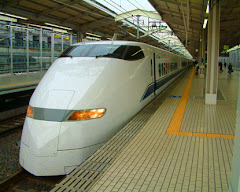From the NY Times, April 16, 2009:
With clogged highways and overburdened airports, economic growth is suffering, Mr. Obama said at the Eisenhower Executive Office Building, shortly before leaving for a trip to Mexico and then Trinidad and Tobago.
“What we need, then, is a smart transportation system equal to the needs of the 21st century,” he said, “a system that reduces travel times and increases mobility, a system that reduces congestion and boosts productivity, a system that reduces destructive emissions and creates jobs.”
And he added, “There’s no reason why we can’t do this.”
Mr. Obama said the $8 billion for high-speed rail in his stimulus package — to be spent over two years — and an additional $1 billion a year being budgeted over the next five years, would provide a “jump start” toward achieving that vision.
The stimulus money has yet to be allocated to specific projects, but Mr. Obama said the Transportation Department would begin awarding money by the end of summer.
The government has identified 10 corridors, each from 100 to 600 miles long, with greatest promise for high-speed development.
They are: a northern New England line; an Empire line running east to west in New York State; a Keystone corridor running laterally through Pennsylvania; a major Chicago hub network; a southeast network connecting the District of Columbia to Florida and the Gulf Coast; a Gulf Coast line extending from eastern Texas to western Alabama; a corridor in central and southern Florida; a Texas-to-Oklahoma line; a California corridor where voters have already approved a line that will allow travel from San Francisco to Los Angeles in two and a half hours; and a corridor in the Pacific Northwest.
Only one high-speed line is now operating, on the Northeast corridor between Washington and Boston, and it will be eligible to compete for money to make improvements.
Mr. Obama’s remarks mixed ambition and modesty, reflecting the fact that American high-speed rail is in its infancy compared with systems in France and Japan.
“Imagine whisking through towns at speeds over 100 miles an hour, walking only a few steps to public transportation, and ending up just blocks from your destination,” Mr. Obama said. “It is happening right now; it’s been happening for decades. The problem is, it’s been happening elsewhere, not here.”
The Federal Railroad Administration defines high-speed rail as any train traveling 90 m.p.h. or faster. In Japan, the Shinkansen trains average about 180 m.p.h. The TGV train in France uses special tracks to sustain speeds of 133 m.p.h. on the Paris-Lyon route.
The Acela Express operated by Amtrak is capable of a speed of 150 m.p.h., but track conditions and other rail traffic bring its average speed to just over half that.
15 years ago




No comments:
Post a Comment